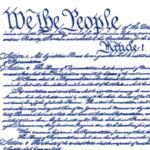The lesson opens with reflective questions that ask students to consider their knowledge of famous Supreme Court cases and rulings, the issues that the Court addressed last term and the last term’s impact, and potential issues that the Court may address during this term. Students then watch, analyze, and respond to an introductory video in which Supreme Court Justice Stephen Breyer talks about the process that the Supreme Court uses to select cases each term. Next, students engage in an activity where they choose to study three cases that will be argued in front of the Supreme Court during this term. Students will conduct additional self-guided research as needed to determine each case’s petitioner(s) and respondent(s), key issue(s), expected outcome, facts of the case, and question(s) before the court, presenting their findings to the class.
Article V and the 27 Amendments – Module 15 of Constitution 101
With the Constitution, the Founding generation created the greatest charter of freedom in the history of the world. However, the Founding generation did not believe that it had a monopoly on constitutional wisdom. Therefore, the founders set out a formal amendment process that allowed later generations to revise our nation’s charter and “form a more perfect Union.” They wrote this process into Article V of the Constitution. Over time, the American people have used this amendment process to transform the Constitution by adding a Bill of Rights, abolishing slavery, promising freedom and equality, and extending the right to vote to women and African Americans. All told, we have ratified 27 constitutional amendments across American history. Learning objectives: Describe the reasons that the Founding generation included a formal process for amending the Constitution;
explain how the Constitution’s amendment process works, and why the founders made it so hard to amend the Constitution; identify the key periods of constitutional change in American history and outline factors that drive successful pushes to amend the Constitution; describe all 27 amendments to the U.S. Constitution.
The Constitution EXPLAINED
This comprehensive, short-form video series explains the text, history, and relevance of the United States Constitution, Bill of Rights, and additional amendments. The videos are assignable and end with call-to-action questions, prompting learners to further explore the topics covered in the video through a modern lens. Click on each category to see its related videos, and click on the video thumbnail to watch the full clip. You can also autoplay each category’s videos using YouTube playlists. The series was developed in partnership with the Center for Civic Education, and with the contributions of constitutional scholar Linda R. Monk, JD.
Voting Rights
The right of a citizen to vote is not directly protected in the Constitution, and throughout our history that right has often been granted to some, but denied to others. However, through various amendments to the Constitution, the right to vote has become more and more inclusive. Uncover the battle for voting rights in the National Constitution Center’s learning module.
Constitution Clips
C-SPAN’s Constitution Clips makes the U.S. Constitution come alive by providing teachers and students with video clips from C-SPAN’s Video Library of the Constitution in action.
Constitution of the United States with Index and the Declaration of Independence, Pocket Edition

This is the 25th pocket edition of the complete text of two core documents of American democracy, the Constitution of the United States (with amendments) and the Declaration of Independence. The resolution calling for the ratification of Constitutional Convention is also included. A topical index to the Constitution is provided. (House Document 112-29, 2012)
Citizenship and the U.S. Constitution
In this lesson students will examine the concept of “citizen” from a definitional perspective of what a citizen is and from the perspective of how citizenship is conferred in the United States. Students will discuss the rights and responsibilities of citizens and non-citizens and review the changing history of citizenship from colonial times to the present.
Win the White House (Game and Teacher Guide)
In Win the White House, your students take on the role of presidential candidate from the primary season all the way through to the general election. The player strategically manages time and resources to gain control of as many electoral votes as possible over a ten-week campaign. This can only be done by effectively communicating his or her position on issues, and mastering media and public appearances.
Our Constitution
The Our Constitution book, written by Donald A. Ritchie and JusticeLearning.org, takes an in-depth look at the Constitution, annotated with detailed explanations of its terms and contents. Included are texts of primary source materials, sidebar material on each article and amendment, profiles of Supreme Court cases, and timelines. The complete book or individual chapters can be downloaded.
Bring the Constitution to Life!

Locate primary sources from the holdings of the National Archives related to such topics as “checks and balances,” “representative government,” all 27 amendments, and other concepts found in the Constitution. This special home page devoted to the U.S. Constitution also features activities to share with students, such as “The Constitution at Work,” which uses primary sources to demonstrate the Constitution in action in our everyday lives.
